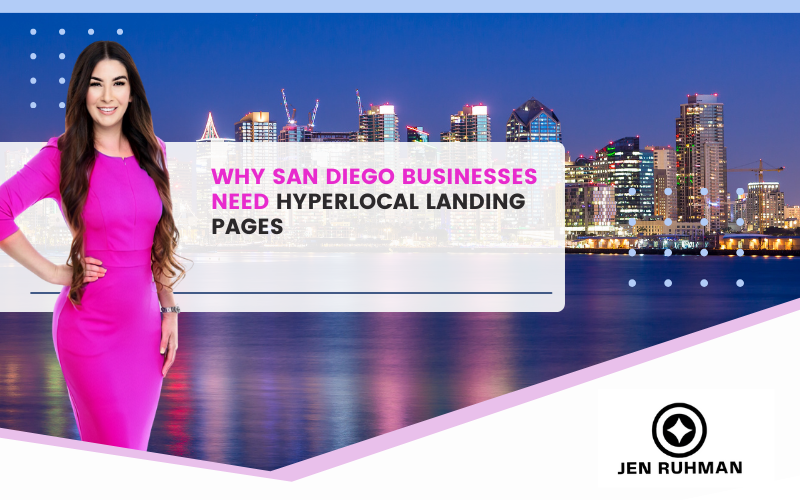Why San Diego Businesses Need Hyperlocal Landing Pages
I’m Jen Ruhman, and I help San Diego businesses show up where it matters—right in front of local customers who are ready to buy. After auditing hundreds of sites across the county, I can tell you this with confidence: ranking for “San Diego” alone isn’t enough. If you want steady leads from real neighborhoods like North Park, Hillcrest, and La Jolla, you need hyperlocal landing pages.
I’ve watched this single tactic lift impressions, raise click-through rates, and drive qualified calls within weeks. Here’s how to do it the smart way.
What Is a Hyperlocal Landing Page?
A hyperlocal landing page targets a specific neighborhood, city pocket, or suburb—not the whole county. Instead of one generic “San Diego” services page, imagine focused pages like:
Plumber in North Park
Injury Lawyer in Chula Vista
Pilates Studio in Pacific Beach
Electrician in Encinitas
Each page speaks directly to people in that area, uses terms they search, and answers location-specific questions (parking, directions, hours, nearby landmarks).
Why Hyperlocal Works in San Diego
1) It matches real search behavior
People don’t only search “best coffee San Diego.” They search “best coffee in Little Italy,” “Hillcrest brunch,” or “La Jolla family dentist.” Google rewards pages that match that level of specificity with content about that exact area.
2) It helps you outrank bigger competitors
Large brands often stick to broad location pages. Your advantage as a local business is agility—ship focused pages faster and win those long-tail, high-intent searches before they do.
3) It increases conversions with local trust signals
When someone from Mission Valley lands on a Mission Valley page with nearby landmarks, directions from Friars Rd., and reviews from neighbors, they feel understood—and they’re more likely to call or book.
What to Include on Every Hyperlocal Page
Essential elements
Neighborhood-specific intro: Name the neighborhood early and naturally (once in the H1 or first paragraph).
Local landmarks and context: Streets, parks, schools, business districts, transit stops.
Unique value for that area: Same-day service windows, after-work hours, weekend availability, bilingual staff—whatever matters locally.
Trust proof close to the CTA: Reviews from nearby customers, local awards, neighborhood partnerships.
Driving/parking info: Short, practical directions and parking tips save headaches and reduce no-shows.
Photos that feel authentic: The exterior of your location, staff on site, or recognizable neighborhood scenes.
Technical must-haves
One primary keyword per page (e.g., “Acupuncture La Jolla”).
Unique title tag & meta description (no duplicates).
Clean, short slug using the neighborhood name.
Internal links to your services, blog, and contact page.
NAP consistency (Name, Address, Phone) that matches your Google Business Profile serving that area.
A Quick San Diego Success Story
A local wellness clinic came to me with one catch-all services page for “San Diego.” We built dedicated pages for Encinitas, Del Mar, and La Jolla, each with real client testimonials from those neighborhoods and clear parking directions (huge in beach communities). Within 90 days, they earned first-page visibility for “acupuncture la jolla” and “fertility acupuncturist encinitas”—and their phone calls jumped by 40%. Most new patients said, “I found you on Google and saw you’re right by me.”
How Many Hyperlocal Pages Should You Build?
Start with 3–5 highest-value neighborhoods where you already serve customers or can reliably deliver within your best turnaround time. Expand from there based on search volume, conversion data, and operational capacity. The goal is quality > quantity—thin, copy-pasted pages won’t rank long-term.
Avoid These Common Mistakes
Copy-pasting the same page with only the neighborhood swapped. Make each page at least 70–80% unique.
Forgetting internal links. Each hyperlocal page should naturally link to your core services and your contact page.
Stuffing keywords. Write for humans first. Use the neighborhood name in logical spots (H1, first paragraph, one subheading, image alt text).
Ignoring page speed. Many local searches happen on mobile. Keep images compressed and pages fast.
Not tracking separately. Use unique slugs and monitor performance per neighborhood in Search Console.
My Simple Build Framework (Steal This)
Research & map demand: Pull keyword ideas tied to each neighborhood + service (e.g., “roof repair north park,” “roofing hillcrest”).
Outline for one service + one neighborhood:
H1 with service + neighborhood
Short intro that validates the searcher’s intent
Benefits specific to that area (availability, proximity, climate/terrain notes)
Social proof from local customers
Directions/parking + key landmarks
Clear CTA (call, book, or form)
Write ~800–1,100 words of helpful, unique content per page.
Add original photos, schema, and internal links.
Publish, request indexing, and track KPIs (impressions, clicks, calls, bookings).
Ready to Put This Into Action?
I build hyperlocal page frameworks for San Diego businesses every week and would love to help you roll this out the right way. If you’re comparing providers, here are two helpful links:
Work with a proven SEO company in San Diego that understands neighborhood-level intent.
Get strategic guidance from an SEO expert in San Diego to plan, write, and launch pages that convert.
Call/Text me directly at (619) 719-1315
FAQs
How many neighborhoods should I target first?
Start with 3–5 high-intent areas where you already see demand or fast service times. Expand gradually as you gather data and win rankings.
Do I need a physical address in each neighborhood?
No. Service-area businesses can still rank with strong content, clear coverage areas, consistent NAP, and a well-optimized Google Business Profile.
Can I use the same testimonials on multiple pages?
Use at least one review from the specific neighborhood where possible. Sprinkle a few general reviews as needed, but prioritize local proof.
How quickly will I see results?
Many clients see movement in 30–90 days, depending on competition, content quality, and site health. Focus on quality and consistency.


